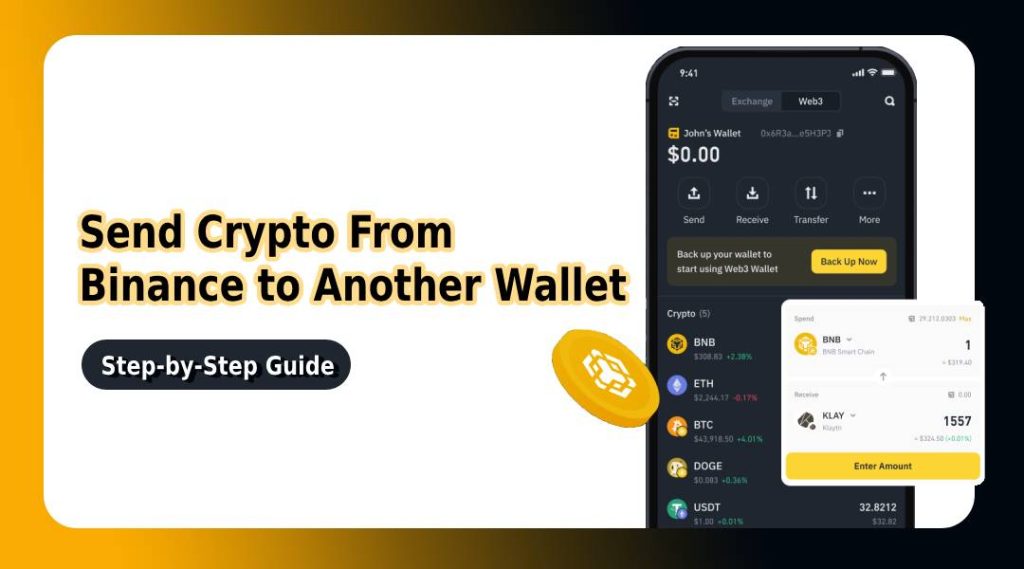Sending cryptocurrency from your Binance account to another wallet might sound complicated at first, but once you understand the steps, it’s actually quite straightforward. Whether you’re looking to withdraw BTC on Binance, transfer Ethereum to a hardware wallet, or just send crypto to a friend, this guide will walk you through everything you need to know.
In this blog, we’ll focus on the process of how to send crypto from Binance, though the same steps generally apply to most other cryptocurrencies.
Why Would You Transfer Crypto from Binance?
Before we get into the step-by-step guide, let’s quickly go over why you might want to transfer your crypto from Binance to another wallet:
- Increased Security: Keeping your crypto in a personal wallet (especially a hardware one) gives you full control over your private keys.
- Long-term storage: If you plan to hold Bitcoin or other coins for the long haul, transferring them to a cold wallet is smart.
- Payments or Transfers: Maybe you’re paying someone or sending funds to your own wallet on another exchange.
No matter your reason, understanding how to do it properly helps avoid costly mistakes.
What You Need Before You Start
To send crypto safely from Binance, make sure you have the following:
- A Binance account with crypto in your Spot or Funding wallet.
- The recipient’s wallet address (whether that’s your own wallet or someone else’s).
- Access to 2FA authentication, if enabled on your Binance account.
- Basic understanding of the blockchain network you’ll use for the transfer.
Step-by-Step: How to Send Crypto from Binance
Let us break down the procedure into simple, easy-to-follow steps.
Step 1: Log In to Your Binance Account
Go to Binance.com or open the Binance app and log in. If you’ve enabled two-factor authentication (2FA), you’ll be prompted to enter a verification code.
Step 2: Go to the “Fiat and Spot” wallet.
Once logged in:
- Click on “Wallet” in the top menu.
- Choose “Fiat and Spot”—this” is where most of your crypto assets will be stored.
If your Bitcoin is in the Funding Wallet or Earn, you’ll need to transfer it to your Spot Wallet first.
Step 3: Click on “Withdraw.”
On the wallet page:
- Find Bitcoin (BTC) in your asset list.
- Click on “Withdraw” next to it.
This will bring up the withdrawal interface, where you may enter the transfer details.
Step 4: Enter the Recipient’s Wallet Address
Paste the wallet address where you want to send the Bitcoin. This could be:
- Your own hardware wallet (like Ledger or Trezor),
- Another exchange wallet,
- A friend or business contact.
Important Tip: Always double-check the wallet address. Crypto transfers are irreversible. Even one wrong character can result in permanent loss of funds.
Step 5: Choose the Correct Network
This is one of the most important steps. Binance supports multiple networks for sending Bitcoin, such as:
- BTC (Bitcoin Network)—The original, most secure network. Recommended if you’re unsure.
- BEP20 (Binance Smart Chain)—Faster and cheaper, but only use if the recipient wallet supports it.
- ERC20 (Ethereum Network)—Common for tokens like USDT, but higher fees.
Best Practice: When in doubt, use the native network for that coin. For Bitcoin, that’s the BTC network.
Step 6: Enter the amount of BTC you wish to send.
Specify how much Bitcoin you’d like to transfer. Binance will automatically calculate the network fee and show you the total amount that will be received.
Pro Tip: It’s smart to send a small test transaction first before sending a large amount, especially if it’s your first time transferring to a new wallet.
Step 7: Review and Confirm the Transaction
Double-check everything:
- Wallet address
- Network
- Amount
- Fees
Review everything carefully. If all looks good, click “Confirm.”
Step 8: Complete Security Verification
Binance uses 2FA and email/SMS verification to secure withdrawals. Enter the requested codes to authorize the transaction.
This added security ensures that even if someone accessed your account, they wouldn’t be able to withdraw your funds without your second layer of authentication.
Step 9: Wait for Blockchain Confirmation
Once submitted, the transaction will be broadcast to the blockchain. You can expect:
- Bitcoin (BTC) transfers to take 10–30 minutes, depending on network congestion.
- You may track the transaction status via:
- Binance’s internal transaction history.
- A blockchain explorer like Blockchain.com or BTCscan.org using the TXID.
Recent Blog: How to Withdraw Crypto from Binance to Bank Account?
Bonus Tips for a Secure Transfer
- For long-term storage, use hardware wallets like the Ledger or Trezor.
- Turn on withdrawal whitelist in Binance to only allow transfers to saved addresses.
- Always use 2FA for your Binance account.
- Never share your wallet seed phrase with anyone.
Still Have Questions?
At Crypto ATM Expert, we help you navigate the crypto world with confidence and clarity.
If you need help with sending crypto or want expert advice, visit us at cryptoatmexpert.com or contact our friendly support team today.
We’re here to help!
Final Thoughts
Sending crypto from Binance to another wallet doesn’t have to be stressful. With the right steps and a little caution, you can transfer your Bitcoin or any other cryptocurrency safely and confidently. Whether you’re managing your own crypto portfolio or just getting started, knowing how to transfer BTC to another wallet is a skill every crypto user should master.
Frequently Asked Questions (FAQs)
What happens if I choose the wrong network?
If the recipient wallet doesn’t support the network you selected (like BEP20 or ERC20), the crypto could be lost permanently. Always confirm network compatibility first.
Can I cancel the transaction after clicking “Withdraw”?
No. Crypto transactions are final once submitted. There is no “undo” button in blockchain. Always review before confirming.
Is there a fee to send crypto from Binance?
Yes, Binance charges a small withdrawal fee based on the asset and network selected. This is displayed during the withdrawal process.
How long does a crypto withdrawal take from Binance?
Most withdrawals are processed within minutes, but it can take up to an hour or more during network congestion.


